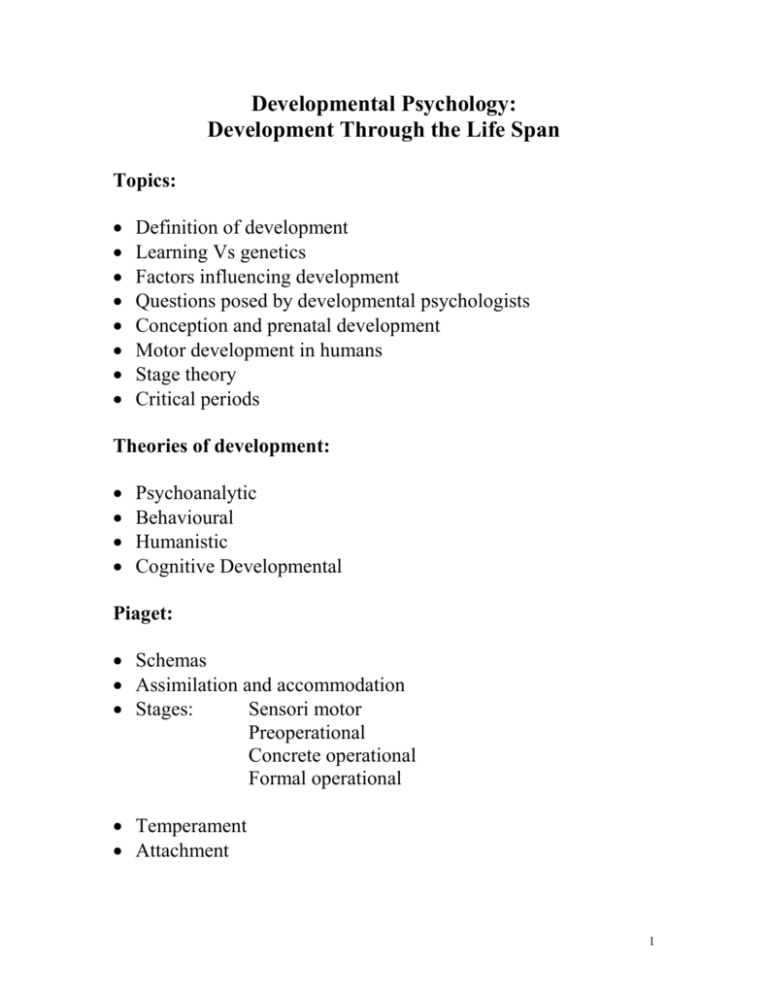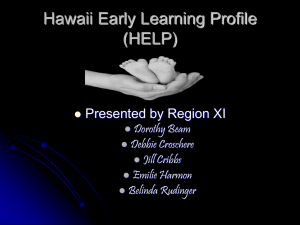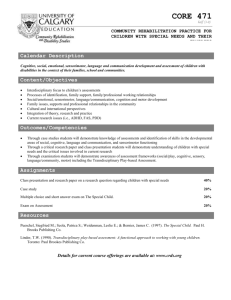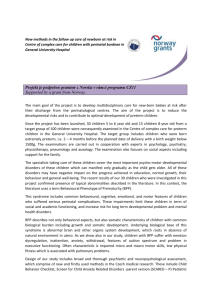Developmental Psychology
advertisement

Developmental Psychology: Development Through the Life Span Topics: Definition of development Learning Vs genetics Factors influencing development Questions posed by developmental psychologists Conception and prenatal development Motor development in humans Stage theory Critical periods Theories of development: Psychoanalytic Behavioural Humanistic Cognitive Developmental Piaget: Schemas Assimilation and accommodation Stages: Sensori motor Preoperational Concrete operational Formal operational Temperament Attachment 1 Adolescent Development Aging Development – definition The study of changes in an organism’s thinking and behaviour which occur over a life span (pre-natal, childhood, adolescence, adulthood, aging) We are always in a state of becoming – developmental psychology is concerned with when and how we change Developmental psychologists study: Physical development (growth, strength, motor coordination) Cognitive development (changes in ways that information is processed) Sensory/perceptual development Personality development Social development Of all mammals, humans have: The longest time to full physical development The longest period of learning The longest time to self sufficiency Primary factors influencing development: Biological maturation Experience Internal drives (motivation) 2 Developmental psychologists are concerned with 3 main questions: 1) How biological determinants and environment interact? Pre-natal: uterine environment is critical for child development – German measles (1st 3 months), smoking, drugs, alcohol (FAS and retardation) Post-natal: environment Vs genetics 2) Is development gradual or does it take place in discrete stages? 3) Stability Vs change: Are dispositions such as personality stable over one’s life or are they subject to change? Conception and pre-natal development: In the womb, the child learns such stimuli as the mother’s voice, the sound of her respiration and heart beat When born, children have reflexes for rooting, sucking, aversion to pain 3 Motor development: Motor development occurs in the same sequence with all children over the entire world but at different rates (considerable variation in terms of rate of development) Sequence of motor development: Rolling over Sitting Standing holding onto something Crawling Walking Much of motor development is tied to the process of maturation Maturation includes physical development (strength & coordination) as well as the expression of biological determinants during development such as: sex, skin colour, eye colour, hair colour Note: extra stimulation can accelerate motor development (e.g., holding a child upright can help induce stepping movements) Also, there is some evidence that speech development can be accelerated (studies on pre-natal stimulation) 4 Stages of development: What do we mean by the term “stages of development”? Behaviours at any stage are organized around a common theme or set of characteristics Behaviours that develop at one stage are different from those that develop at other stages All children go through the same stages in the same order but the duration of each stage can vary Critical periods: The concept of critical period is closely related to the concept of stages in development Definition: Crucial time periods during development when an organism must be exposed to specific events or types of stimuli in order for development to occur normally The brain starts off with an abundance of neurons and becomes sculpted by early experiences (plastic) Neural connections develop in response to specific types of experience We know a fair bit about critical periods in visual development Initially, children are near sighted and show preferences for curved lines, high contrast and interesting shapes 5 Binocular vision develops during early childhood as a result of receiving the same visual information through 2 eyes If eyes are patched during the critical period for human visual development (5-7 yr.) no visual cortical cells will develop with sensitivity to binocular cues Visual and motor experience (e.g., locomotion) must occur together during early childhood or problems will develop with visual/motor coordination Exposure to varied visual stimuli (e.g., edges of different orientation) must occur in early childhood or the ability to see full range of visual stimuli is restricted (David Hubel & Thurston Wiesel) Prior to the age of about 5 yr., the child’s brain changes a lot as it is sculpted by experience – this is why we are unable to recall early childhood memories Note: The term critical period usually refers to aspects of physiological development (e.g., perceptual motor work of Stewart Anstis in colour vision) In cognitive development, psychologists usually refer to sensitive stages in a child’s development Language development shows sensitive stages (6-7 yr.). If a child is not exposed to language by or during this time, language ability may not develop properly 6 Difficulty experienced by researchers when trying to measure infant abilities before language has developed (e.g., habituation studies in vision) Theories of Development: Psychoanalytic (Freud): We develop as a result of conflicting biological and social forces How these conflicting forces are reconciled at different stages of development affects how the child psyche unfolds (dynamic aspect of development) Freud’s stages of development Age 0 – 1.5 yr. Stage Oral 1.5 – 3 yr. Anal 3 – 6 yr. Phallic 6 – 12 yr. Latent 12 – 18 Genital Characteristic Fixation on oral sensation Learning to control body functions Learning sex role identification Repression of sexuality Heterosexual interest 7 Behavioural Theory: Don’t believe in stages Development is a function of learning and is directly related to environmental influences and the sequences with which they occur We learn throughout our entire life time Learning is explained by: Classical conditioning (respondent learning – controlled by what comes before) Operant conditioning (controlled by what comes after) Social learning (learning by observation and imitation) Humanistic Theory: Focus on each person being unique and having free will to make choices throughout life Concepts used include: self, growth, motivation, self actualization, holistic Cognitive developmental theory: Child not viewed as passive, as with psychoanalytic and behavioural views Also called Piagetian theory after the famous Swiss psychologist 8 Development is related to states of disequilibrium between an individual’s current knowledge and the actual state of the world Stages of development take place in a fixed order Children are not little adults but are in fact very different from adults in their ways of seeing and thinking about the world Information Processing: Development related to experience, maturation and the development of cognitive abilities or ways of thinking There are no stages, rather there are sensitive times for different aspects of cognitive development Leads to a gradual development or an unfolding of the child Jean Piaget (1886-1980) Cognitive Developmental Theory) Perhaps the most influential developmental psychologist The stages of child development he identified were based largely on observational studies of his own children (case study) The child is viewed as an active participant in their own development Children develop schemas (theories of frameworks) of how the physical and social worlds work 9 Two processes are involved in the creation, maintenance and changing of schemas Assimilation: Fitting experiences to existing frameworks or schemas Accommodation: Having to change schemas to fit experiences (e.g., egocentrism & animism) Stages of Piaget’s Cognitive Development Theory: 1) 2) 3) 4) Sensori motor: Preoperational: Concrete operational: Formal operational: birth to 2 yr. 2 – 7 yr. 7 – 11 yr. 11 to adulthood Sensori Motor Stage (birth to 2 yr.) Development of reflexes, coordination and sensory systems Child becomes focused on their actions and the consequence of their actions Child begins to develop a sense that they are separate from the world Develop understanding of “object permanence” by about 9 months. This requires ability to create mental representations of the missing object – the beginnings of conceptual thinking 10 Language starts to develop and the child starts to use words as symbols for things Beginnings of symbolic play such as riding a broom, pretending it’s a horse Pre-operational Stage (2 – 7 yr.): The child is talking but does not understand the logical aspects of language (grammar) The concept of conversion is not yet understood Around 5 yr., the child starts to develop a sense of obligation to follow rules that things have to be done a certain way Sense of moral responsibility in the world starts to develop Animism is central to this stage Concrete Operational Stage (7-11 yr.): Child starts to think and to use language logically Understanding develops for concepts of conservation (numbers, mass, volume) 11 Formal Operational (11 yr. to adulthood): Children start to think about abstract concepts Concern for the hypothetical, the future and ideological problems Other issues related to development: Babies have different temperaments: happy, easy going, cranky, fidgety, hyper These temperaments are the beginnings of personality Some aspects of temperament such as shyness (introversion – extroversion) can be predicted from the pre-natal environment Birth order influences the development of personality – first born, last born Attachment: Physical interaction between the mother and baby is very important In 1969, Harlow discovered that baby monkeys prefer soft cloth surrogate mother without milk to a wire mother with milk 12








